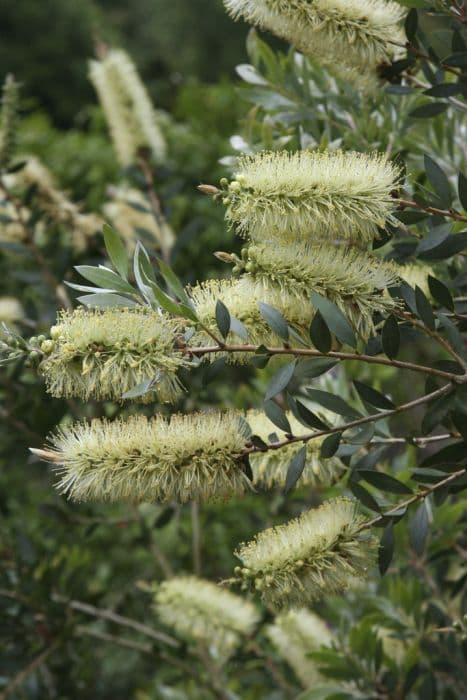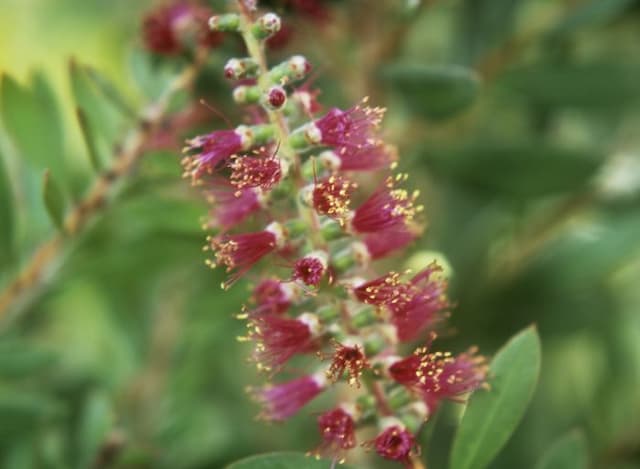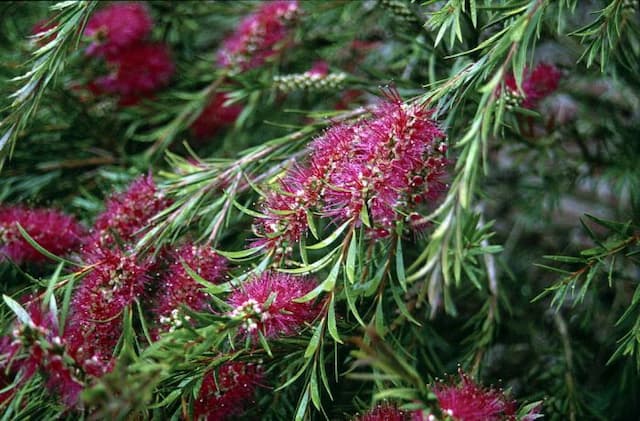Tick Bush Kunzea ambigua

ABOUT
Commonly known as the white kunzea, this plant features clusters of small, fluffy white flowers that give a frothy appearance when in full bloom. The flowers have a distinctive arrangement of stamens that lend a brush-like look to the floral structure. Beneath the blooms, the foliage is comprised of small, narrow leaves that are often aromatic when crushed. The leaves are pointed and exhibit a glossy green hue, providing a dense and bushy backdrop for the white flowers. The branches of white kunzea spread outwards, creating a somewhat rounded and sprawling shape that contributes to its attractive and natural aesthetic. The bark tends to peel off in strips, revealing a smooth surface underneath, which can add texture to the overall profile of the plant. The white kunzea exudes a fresh, pleasant scent, especially when the leaves are pressed or brushed against, adding another layer of sensory appeal to this striking plant.
About this plant
 Names
NamesFamily
Myrtaceae
Synonyms
White Kunzea, Tick Bush, Poverty Bush, White Cloud, Snow-In-Summer
Common names
Kunzea ericifolia, Kunzea peduncularis, Leptospermum ericifolium, Leptospermum ambiguum, Leptospermum ellipticum, Leptospermum parvifolium.
 Toxicity
ToxicityTo humans
Kunzea ambigua, commonly known as White Kunzea, is not widely documented as a toxic plant to humans. There is limited information available on the consequences of ingesting this plant. However, as with any plant, individual allergies or sensitivities may exist and accidental ingestion should be treated with caution. If symptoms develop after ingesting any part of White Kunzea, it is essential to consult a healthcare professional.
To pets
White Kunzea is also not widely recognized as a toxic plant to pets. There is a lack of specific information on the toxicity of this plant to dogs, cats, or other domestic animals. Despite this, pet owners should prevent their animals from consuming plants not meant for their consumption. If a pet does ingest White Kunzea and shows signs of distress or unusual behavior, it is advisable to contact a veterinarian immediately.
 Characteristics
CharacteristicsLife cycle
Perennials
Foliage type
Evergreen
Color of leaves
Green
Flower color
White
Height
10 feet (3 meters)
Spread
8 feet (2.4 meters)
Plant type
Shrub
Hardiness zones
9
Native area
Australia
Benefits
 General Benefits
General Benefits- Essential Oil Production: Known for its aromatic qualities, Kunzea ambigua is a source of essential oil used in aromatherapy and perfumery.
- Landscape Use: With its attractive white to pale pink flowers, it is commonly used as an ornamental plant in gardens and landscaping projects.
- Wildlife Habitat: Provides a natural habitat and food source for native pollinators, including bees and butterflies.
- Soil Improvement: Can help improve soil quality through its root systems that may prevent soil erosion and enhance soil stability.
- Tolerance to Conditions: Kunzea ambigua is known for its resilience, being able to tolerate a range of conditions including poor soils, drought, and coastal exposure.
 Medical Properties
Medical Properties- Anti-inflammatory: Kunzea ambigua has been traditionally used to reduce inflammation and related pain.
- Antimicrobial: The essential oil derived from the plant is believed to possess antimicrobial properties that can inhibit the growth of certain bacteria and fungi.
- Analgesic: It is commonly used in herbal medicine as a pain reliever for muscle aches and pains.
- Antiseptic: The plant’s oil is used topically as an antiseptic for minor cuts and scrapes.
- Respiratory aid: Inhaling the vapor of the essential oil is thought to help with respiratory conditions by easing congestion.
- Skin conditions: The oil from Kunzea ambigua is sometimes applied to the skin for conditions like eczema, rashes, and insect bites to alleviate irritation and promote healing.
- Stress relief: Aromatherapy uses the soothing scent of the oil for relaxation and stress relief.
 Air-purifying Qualities
Air-purifying QualitiesThis plant is not specifically known for air purifying qualities.
 Other Uses
Other Uses- Insect Repellent: Kunzea ambigua, commonly known as tick bush, has been traditionally utilised for its insect repelling properties, especially for driving away ticks and other biting insects.
- Aromatic Sachets: Dried leaves and flowers of tick bush can be used in sachets to impart a fresh, herbal scent to closets and drawers.
- Natural Deodorizer: The essential oil from tick bush can be added to homemade natural deodorizers to neutralize odors in rooms, shoes, or garbage bins.
- Garden Companion Planting: Tick bush can be planted alongside other crops to attract beneficial insects and provide natural pest control due to its aromatic properties.
- Floral Arrangements: Fresh or dried flowers of tick bush can be incorporated into floral arrangements for their visual appeal and fragrance.
- Wildlife Habitat: The dense foliage of tick bush provides shelter and nesting sites for various native bird species.
- Erosion Control: With its sturdy root system, tick bush can be planted in areas prone to erosion to help stabilize the soil.
- Culinary Experiments: Although not commonly eaten, some adventurous chefs have used the aromatic leaves of tick bush in small quantities to flavor wild game dishes.
- Craft Material: The flexible branches of tick bush can be woven into baskets, wreaths, or other rustic craft items.
- Photography Subject: Due to its picturesque blossoms and interesting foliage, tick bush is often used as a subject in botanical photography.
Interesting Facts
 Feng Shui
Feng ShuiThe Kunzea ambigua, commonly known as the Tick Bush, is not used in Feng Shui practice.
 Zodiac Sign Compitability
Zodiac Sign CompitabilityThe Tick Bush is not used in astrology practice.
 Plant Symbolism
Plant Symbolism- Healing and Therapeutic properties: Kunzea ambigua, commonly known as Tick Bush, is often associated with its healing qualities due to its use in traditional medicine and aromatherapy for soothing muscles and alleviating pain.
- Resilience and Survival: Native to Australia, the Tick Bush thrives in poor soils and challenging environments, symbolizing the ability to persevere and flourish under difficult circumstances.
- Purity and Cleansing: The essential oil derived from the Tick Bush is believed to have purifying properties, making it symbolically tied to cleansing and purity, both physically and in one's environment.
- Protection: In some folk beliefs, the Tick Bush is thought to offer protection. Its name derives from its ability to repel ticks and other parasites, thus it symbolizes safeguarding against harm.
- Natural Balance: With its use in balancing ecosystems by attracting beneficial insects, the Tick Bush represents harmony and the importance of maintaining natural balance.
 Water
WaterThe tick bush should be watered regularly, especially during long periods of dryness, applying roughly 1 gallon of water every week for established plants. It's important to ensure the soil around the tick bush is well-draining to prevent waterlogging, and to reduce watering frequency to about once every two weeks during its dormant winter phase. During the growing season, water deeply once a week, avoiding overhead watering to minimize leaf moisture and potential fungal diseases.
 Light
LightTick bush thrives in full sun to partial shade conditions, preferring a spot that receives at least 6 hours of direct sunlight each day. They can handle coastal conditions well and enjoy the dappled light; however, too much shade can result in fewer flowers and a less vigorous plant.
 Temperature
TemperatureThe tick bush is quite hardy and can withstand a range of temperature conditions. It can survive in temperatures as low as 20°F and as high as 100°F, but it grows best in temperatures between 60°F and 80°F. During frosty conditions, it is advisable to protect younger plants with frost cloth to prevent damage.
 Pruning
PruningPruning the tick bush helps maintain its shape, removes dead or diseased wood, and encourages new growth and flowering. The best time for pruning is at the end of winter or early spring, cutting back by about one-third of the plant's size. Pruning should be done at least once a year, but more frequent light pruning can maintain your desired shape and size.
 Cleaning
CleaningAs needed
 Soil
SoilThe ideal soil mix for Kunzea ambigua, commonly known as tick bush, should be well-draining with a slightly acidic to neutral pH of about 5.5 to 7. A good mix can be created using equal parts of coarse sand, loam, and compost to ensure proper drainage and fertility. Regularly check and maintain the soil pH within this range for optimal growth.
 Repotting
RepottingTick bush (Kunzea ambigua) generally does not need frequent repotting and can be done every 2 to 3 years. It's best to repot in the spring when the plant shows signs of becoming root-bound or if the soil quality has deteriorated. Ensure to use the recommended soil mix when repotting for healthy growth.
 Humidity & Misting
Humidity & MistingTick bush (Kunzea ambigua) thrives in a range of humidity levels and can adapt to the humidity levels typically found in outdoor environments. It is not particular about high humidity and does well with average air moisture, making it versatile for different outdoor settings without requiring any special humidity adjustments.
 Suitable locations
Suitable locationsIndoor
Place in bright, indirect light and ensure good air circulation.
Outdoor
Full sun to partial shade, protect from harsh elements.
Hardiness zone
9-11 USDA
 Life cycle
Life cycleThe common name of Kunzea ambigua is White Kunzea or Tick Bush. The life cycle begins with seed germination, which occurs in the native habitat when soil conditions and temperatures are favorable, often after a period of rain. Seedlings emerge and establish a root system before the growth of stems and foliage. As the plants mature, they form woody shrubs with needle-like leaves and produce distinctive white, fluffy flowers during spring or early summer. These flowers are pollinated by insects, leading to the development of small, woody capsules that contain numerous tiny seeds. The plant reaches the end of its life cycle when it dies after several years, but it ensures its legacy by dropping seeds which can germinate to start the cycle anew.
 Propogation
PropogationPropogation time
Spring to early summer
Propogation: The most popular method of propagating Kunzea ambigua, commonly known as Tick Bush, is through seed sowing. The best time to sow seeds is in the spring after the last frost when temperatures are conducive to germination. The seeds are very small, so they should be surface sown onto a well-draining seed starting mix and lightly covered with a fine layer of soil or vermiculite. They require consistent moisture, so a gentle misting to keep the soil damp without causing water logging is ideal. Adequate light is essential, and placing the seed trays in a bright, indirect sunlight position will improve germination rates. Once the seedlings are large enough to handle, they can be pricked out and transplanted into individual pots. Care should be taken not to damage the delicate roots during this process.









![New Zealand myrtle [Black Pearl]](/_next/image?url=https%3A%2F%2Fplants-admin.emdemapps.com%2Fimages%2Fplants%2F%2Fimages%2F604b53688d37e.png&w=640&q=75)